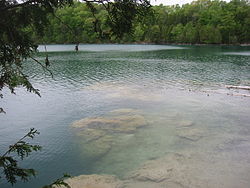Green Lake (New York)
| Green Lake | |
|---|---|

Deadman's Point in May; a "marl reef" is visible in the water.
|
|
| Location | Onondaga County, New York |
| Coordinates | 43°03′00″N 75°57′58″W / 43.05°N 75.966°WCoordinates: 43°03′00″N 75°57′58″W / 43.05°N 75.966°W |
| Lake type | meromictic |
| Basin countries | United States |
| Max. length | 1,141 m (3,743 ft) |
| Max. width | 250 m (820 ft) |
| Surface area | 0.258 km2 (0.100 sq mi) |
| Average depth | 52 m (171 ft) |
| Water volume | 7,235,900 m3 (5,866.2 acre·ft) |
| Shore length1 | 2,840 m (9,320 ft) |
| 1 Shore length is not a well-defined measure. | |
Green Lake is the larger of the two lakes in Green Lakes State Park, which lies about 9 miles (14 km) east of downtown Syracuse in Onondaga County, New York. Round Lake is the smaller lake located west of Green Lake. Both lakes are meromictic, which means no seasonal mixing of surface and bottom waters occurs. Meromictic lakes are fairly rare; they have been extensively studied, in part because their sediments can preserve an historical record extending back thousands of years, and because of the euxinic (anoxic, sulfidic) conditions which can form in the deep water.
Green Lake reaches a maximum depth of 195 feet. Deep lakes tend to appear bluish because the wavelengths of light that can penetrate (and be dispersed at) great depths are those closer to the blue end of the spectrum. Because of its depth and the high salinity of the basin waters, the lake is meromictic and does not turn over and intermix waters like many other lakes in this region do. Green Lake's cold and dense bottom waters tend to stay separate from the shallower, warmer waters. Because of this, sediment sinks and collects in the bottom and virtually does not decay. Since the sediment is not kicked up by mixing, the lake does not take on a muddy, turbid appearance like other lakes do. Meromictic lakes also have still, mirror-like waters. Green Lake is no exception, as its tranquil, reflective water makes for great photography. The lake is glacial in origin, likely developed by glacial meltwater during the most recent North American glaciation, and its calcium and sulfate-rich waters are due to groundwater percolating through marine shale with a high gypsum content. The lake, which resembles a large river in shape, is unusually deep for its size and was regarded as being sacred by the native Onondaga tribe, which originally settled in the area.
Fayetteville Green Lake (FGL) was the first lake in North America identified as meromictic, and is the best-studied meromictic lake in the world, with records dating back to 1839. Green Lake was referred to as Lake Sodom by Lardner Vanuxem, who was the first to study Green Lake in 1839, and the presence of sulfide in the deeper waters of the lake was known by 1849. FGL is believed to have formed as a plunge pool during the late Wisconsin stage of glaciation at the base of a waterfall formed by the retreating glaciers, which is the reason for its extreme depth relative to a small surface area. The outflow for FGL runs underneath the Erie Canal, which is located within 300 m of the north shore of the lake. FGL is currently located in Green Lakes State Park, and since 1933, large quantities of sand have been dumped on the shore of the north end to create a swimming area.
...
Wikipedia
